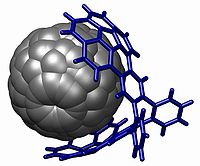- Molecular tweezers
-
 A fullerene bound in a buckycatcher through aromatic stacking interactions Reported by Sygula and coworkers.[2]
A fullerene bound in a buckycatcher through aromatic stacking interactions Reported by Sygula and coworkers.[2]
Molecular tweezers, sometimes termed molecular clips, are noncyclic macro molecular complexes with open cavities capable of binding guests[3]. The term "molecular tweezer" was first used by Howard J. Whitlock,[4] but the class of hosts was developed and popularized by Steven C. Zimmerman in the mid-1980s to early 1990s[5][6][7]. The open cavity of the molecular tweezer may bind guests using non-covalent bonding which includes hydrogen bonding, metal coordination, hydrophobic forces, van der Waals forces, π-π interactions, and/or electrostatic effects. These complexes are a subset of macrocyclic molecular receptors and their structure is that the two "arms" that bind the guest molecule between them are only connected at one end.
Examples
One example of molecular tweezers has been reported by Lehn and coworkers. This molecule is capable of binding aromatic guests.[1] The molecular tweezers are composed of two anthracene arms held at a distance that allows aromatic guests to gain π-π interactions from both.
Another class of molecular tweezers is composed of two substituted porphyrin macrocycles tethered by an amide linker with a variable length. This example of a molecular tweezer shows the potential mobility of this class of molecules, as the orientation of the porphyrin planes which comprise the tweezer can be altered by the guest which is bound [8]
Yet another structure for molecular tweezers which specifically bind fullerenes is called a buckycatcher and has been reported.[2] This molecular tweezer is composed of two concaved corannulene pincers that complement the surface of the convex fullerene guest. An association constant (Ka) of 8600 M−1 between the host buckycatcher and a C60 fullerene was calculated using 1H NMR spectroscopy.
The above examples show the potential reactivity and specificity of these molecules. The binding site between the planes of the tweezer can evolve to bind to an appropriate guest with resulting high association constants and consequent stability, depending on the configuration of the tweezer. That makes this overall class of macromolecule truly a synthetic molecular receptor.[citation needed]
References
- ^ a b A. Petitjean, R. G. Khoury, N. Kyritsakas and J. M. Lehn (2004). "Dynamic Devices. Shape Switching and Substrate Binding in Ion-Controlled Nanomechanical Molecular Tweezers". J. Am. Chem. Soc. 126 (21): 6637–6647. doi:10.1021/ja031915r. PMID 15161291.
- ^ a b A. Sygula, F. R. Fronczek, R. Sygula, P. W. Rabideau and M. M. Olmstead (2007). "A Double Concave Hydrocarbon Buckycatcher". J. Am. Chem. Soc. 129 (13): 3842–3843. doi:10.1021/ja070616p. PMID 17348661.
- ^ Frank-Gerrit Klärner and Björn Kahlert (2003). "Molecular Tweezers and Clips as Synthetic Receptors. Molecular Recognition and Dynamics in Receptor-Substrate Complexes". Acc. Chem. Res. 36 (12): 919–932. doi:10.1021/ar0200448. PMID 14674783.
- ^ Chen C.-W.; Whitlock H. W. "Molecular Tweezers - A Simple-Model of Bifunctional Intercalation," J. Am. Chem. Soc. 1978, 100, 4921
- ^ Zimmerman, S. C.; VanZyl, C. M. "Rigid molecular tweezers: synthesis, characterization, and complexation chemistry of a diacridine," J. Am. Chem. Soc. 1987, 109, 7894.
- ^ Zimmerman, S. C.; Wu, W. "A rigid molecular tweezers with an active site carboxylic acid: exceptionally efficient receptor for adenine in an organic solvent," J. Am. Chem. Soc. 1989, 111, 8054.
- ^ Zimmerman, S. C. "Rigid molecular tweezers as hosts for the complexation of neutral guests," Top. Curr. Chem. 1993, 165, 71.
- ^ X. Huang, N. Fujioka, G. Pescitelli, F. Koehn, R. T. Williamson, K. Nakanishi and N. Berova (2002). "Absolute Configurational Assignments of Secondary Amines by CD-sensitive Dimeric Zinc Porphyrin Host". J. Am. Chem. Soc. 124 (17): 10320–10335. doi:10.1021/ja020520p.
External links
- Journal of Chemical Education Featured Molecules December 2004: Nanoscale Molecular Tweezers and article
- Crystalmaker molecular tweezers
Categories:- Supramolecular chemistry
- Molecular machines
Wikimedia Foundation. 2010.

